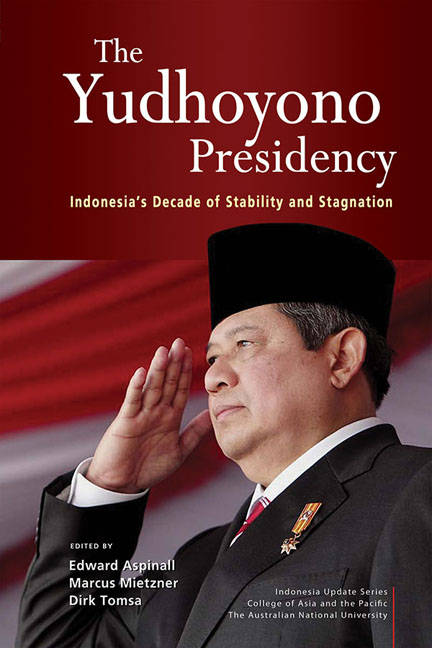Book contents
- Frontmatter
- Contents
- Tables and figures
- Contributors
- Acknowledgments
- Glossary
- 1 The moderating president: Yudhoyono's decade in power
- 2 Prologue Yudhoyono's legacy: an insider's view
- PART 1 PERSONAL, COMPARATIVE AND INTERNATIONAL PERSPECTIVES
- 3 The politics of Yudhoyono: majoritarian democracy, insecurity and vanity
- 4 Men on horseback and their droppings: Yudhoyono's presidency and legacies in comparative regional perspective
- 5 Yudhoyono's foreign policy: is Indonesia a rising power?
- PART 2 INSTITUTIONS, POLITICS AND SECURITY
- PART 3 GENDER, HUMAN RIGHTS AND ENVIRONMENT
- PART 4 THE ECONOMY AND SOCIAL POLICIES
- Index
- Miscellaneous Endmatter
5 - Yudhoyono's foreign policy: is Indonesia a rising power?
from PART 1 PERSONAL, COMPARATIVE AND INTERNATIONAL PERSPECTIVES
Published online by Cambridge University Press: 19 May 2017
- Frontmatter
- Contents
- Tables and figures
- Contributors
- Acknowledgments
- Glossary
- 1 The moderating president: Yudhoyono's decade in power
- 2 Prologue Yudhoyono's legacy: an insider's view
- PART 1 PERSONAL, COMPARATIVE AND INTERNATIONAL PERSPECTIVES
- 3 The politics of Yudhoyono: majoritarian democracy, insecurity and vanity
- 4 Men on horseback and their droppings: Yudhoyono's presidency and legacies in comparative regional perspective
- 5 Yudhoyono's foreign policy: is Indonesia a rising power?
- PART 2 INSTITUTIONS, POLITICS AND SECURITY
- PART 3 GENDER, HUMAN RIGHTS AND ENVIRONMENT
- PART 4 THE ECONOMY AND SOCIAL POLICIES
- Index
- Miscellaneous Endmatter
Summary
When Susilo Bambang Yudhoyono became president of Indonesia in 2004, he took charge of a country whose international reputation had been shaped primarily by political instability, economic hardship and security threats such as terrorism and secessionism. In addition, Indonesia's foreign policy had been devastated by the separation of Timor-Leste and the loss of the Sipadan and Ligitan islands to Malaysia following a decision in the International Court of Justice in 2002. Restoring the country's badly tarnished image became a key priority of Yudhoyono's presidency. At the same time, he aspired for Indonesia to play a more prominent role in international organisations such as the United Nations, the G20 and ASEAN. By the time he left office in 2014, it appeared that Indonesia had indeed defied the inauspicious circumstances at the beginning of Yudhoyono's term in office and re-emerged as a respected player on the global map of international affairs. This remarkable transformation has prompted some observers to describe Indonesia as a rising or emerging power.
This chapter seeks to assess the merits of these claims and analyse Yudhoyono's role in shaping Indonesia's foreign policy during the ten years of his presidency, paying particular attention to an apparent paradox. On the one hand, Indonesia's growing international reputation as a rising or emerging power is often attributed to its successful democratisation and its image as a model Muslim democracy (Acharya 2014). Western governments in particular have not tired of praising Indonesia's achievements under Yudhoyono's leadership (Leahy 2014; Santi 2014). On the other hand, however, both the media and academic observers of Indonesian domestic politics have increasingly questioned whether the country really deserves this praise (Harsono 2012). In this chapter, I argue that this seeming paradox is explained in part by Yudhoyono's approach to foreign policy. As I will demonstrate, the president's personality heavily shaped Indonesia's approach to foreign affairs, especially during his second term when he made the narrative of a successful Muslim democracy a cornerstone of his foreign policy. Building on the appeal of this narrative, Yudhoyono brought Indonesia back into the community of nations, restoring its visibility in the eyes of the international community. It would be premature, however, to consider Indonesia a rising power.
- Type
- Chapter
- Information
- The Yudhoyono PresidencyIndonesia's Decade of Stability and Stagnation, pp. 73 - 90Publisher: ISEAS–Yusof Ishak InstitutePrint publication year: 2015

